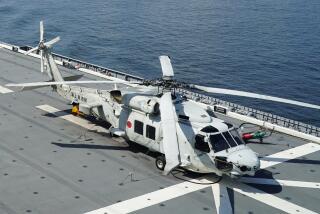Malaysia missing plane search spurred by new sighting

KUALA LUMPUR, Malaysia — Spurred by additional satellite leads, Australian officials on Sunday ramped up a multinational effort to comb a vast stretch of the south Indian Ocean for traces of missing Malaysia Airlines Flight 370.
The Australian Maritime Safety Authority said eight military and civilian aircraft carrying 20 volunteer spotters — double the number used Saturday — would look for objects that were shown floating about 1,500 miles off the coast of western Australia.
An Australian navy vessel also began to conduct a search, and more ships were on the way.
Sunday was the fourth day of an operation that has focused on this remote area of the Indian Ocean since Australia, and then China, spotted satellite images of large objects that could be wreckage from Flight 370, which left Kuala Lumpur for Beijing on March 8 with 239 people on board.
Although officials continued to call it a search and rescue operation, Australia’s maritime authority said that the effort was challenging and “continues to hold grave fears for the passengers and crew on board the missing flight.”
The search effort has been both high-tech and labor intensive. Authorities for the first time deployed four commercial planes, because of their ability to sweep the search area for as long as five hours, three more than the P-3 Orions and U.S. Navy P-8 Poseidon aircraft that have been used in the search.
Sunday’s search was expected to cover an even larger expanse of these normally rough waters than before, about 22,800 square miles, with marker buoys helping to track the ocean currents.
Although no sightings of possible airplane debris have been reported, the effort in this part of the Indian Ocean received new impetus after China on Saturday released images of a large object floating in an area about 75 miles from where Australian satellite images had shown two objects, one similar in size.
A Chinese defense agency said on its website that satellite pictures taken around noon Tuesday showed an object measuring 74 feet by 43 feet southwest of where Australia two days earlier captured images of the two objects, one of them estimated at 79 feet long. Australian officials have said these could be related to the missing plane.
Since Australia reported its satellite sightings Thursday, an increasingly intensifying effort has been undertaken to comb the waters. But Saturday’s hunt ended with aircraft equipment and human spotters finding little more than a wooden pallet and clumps of seaweed, said the Australian Maritime Safety Authority, which is coordinating the operation in that area.
In a statement, the maritime agency said it had plotted the position of the new Chinese satellite image and that it fell within Saturday’s search area. The authority said it would take the new information into account in Sunday’s search plans, which could be affected by bad weather.
The report of the Chinese image came amid concern that any objects seen by satellite days ago may already have sunk, but it is still likely to give further motivation to the multinational search in the so-called southern corridor that is thought to be a likely path taken by Flight 370.
Malaysia’s defense minister, Hishammuddin Hussein, said that China was dispatching ships to the area of the object sightings.
China already has five ships in the southern corridor and is sending two more, Hishammuddin said in a statement during a daily press briefing, which was cut short by the Chinese satellite news. He also said two Chinese aircraft capable of hauling heavy items were to join Australia, the United States and New Zealand in the search operations.
Two merchant ships and an Australian navy vessel also are in the search area.
Japanese planes were to arrive Sunday, and two Indian aircraft that landed in Malaysia on Friday night also will assist with the search in the southern area, Hishammuddin said. In addition, a British vessel equipped with underwater search sensors was en route, he said.
Despite the growing and sophisticated resources, the operation has proved daunting because of not only the large search area but also the generally strong currents and rough seas in this remote section of the Indian Ocean.
Hishammuddin said there was a cyclone warning for the southern corridor.
On Saturday, weather conditions and visibility were good as four Orion military aircraft and two long-range commercial planes scoured the area, with 10 volunteer air observers helping to look for any objects that could be related to the missing jetliner.
Australia’s maritime agency said observers in one of the civilian planes spotted a number of small objects, including a pallet, within a radius of about three miles, but an inspection later by a New Zealand Orion found only seaweed.
Despite the lack of success thus far, Malaysian officials have pledged to keep search operations going for as long as there is hope.
“I know this roller-coaster has been incredibly hard for everyone, especially for the families,” Hishammuddin said Saturday. “We hope and pray this difficult search will be resolved, and bring to closure to those whose relatives were on board.”
More to Read
Start your day right
Sign up for Essential California for news, features and recommendations from the L.A. Times and beyond in your inbox six days a week.
You may occasionally receive promotional content from the Los Angeles Times.







